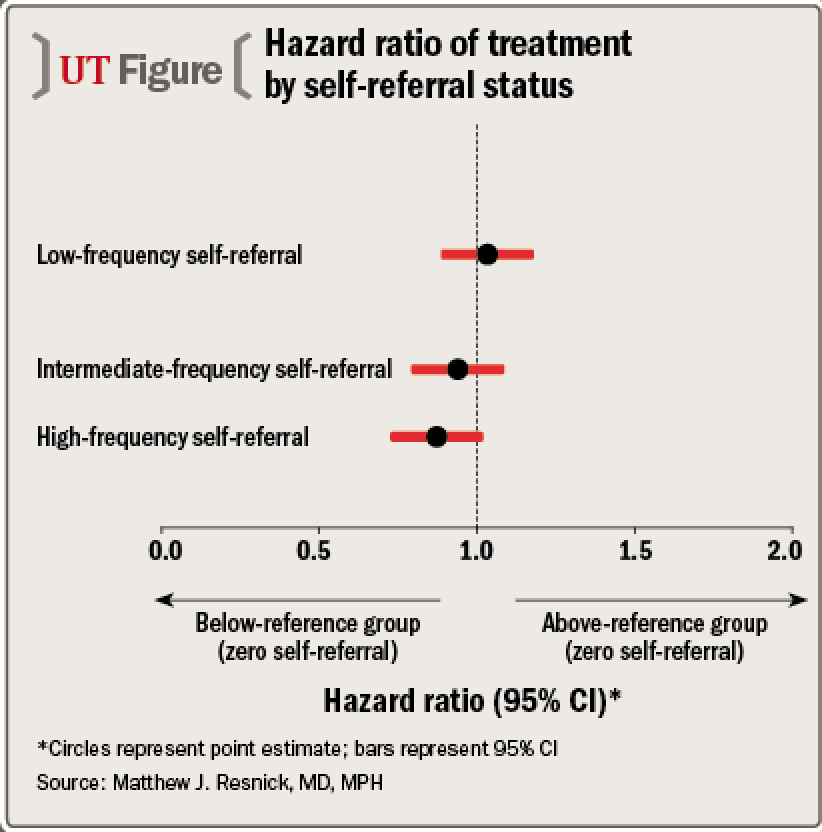Article
Urologist self-referral increases likelihood of CT, ESWL
Author(s):
A review of initial surgical management for patients with urolithiasis has identified an association between urologist self-referral and an increased likelihood of undergoing computed tomography imaging and extracorporeal shock wave lithotripsy (ESWL) compared with non-self-referring physicians.
Nashville, TN-A review of initial surgical management for patients with urolithiasis has identified an association between urologist self-referral and an increased likelihood of undergoing computed tomography imaging and extracorporeal shock wave lithotripsy (ESWL) compared with non-self-referring physicians.
RELATED: Fluids, meds highlight ACP stone prevention guide
Understanding the impact of health care delivery systems on practice patterns is essential for developing health care policy changes that support best practice and for enabling urologists to succeed in the new value-based health care environment, according to first author Matthew J. Resnick, MD, MPH.
To that end, Dr. Resnick and colleagues at Vanderbilt University, Nashville, TN, undertook a study to examine relationships between urologist self-referral, in which a physician is presumed to have a financial interest in performing a test or service, for advanced imaging and surgical treatment for urinary stone disease.
Using data from the Medicare 5% Standard Analytic Files for the years 2009 and 2010, their analyses showed patients treated by self-referring urologists were more likely to undergo CT imaging than patients managed by non-self-referring physicians. Interestingly, the study also found that patients treated by self-referring urologists were less likely to undergo surgical treatment for their stone disease. However, when patients did receive treatment, it was more likely to be with ESWL than either ureteroscopy or ureteral stenting.
Next: Reasons for association 'largely unknown'

More on Stone Disease
How do you manage large kidney and ureteral stones?
Study: Ultrasound over CT for initial stone Dx
Stone patients at greater risk for CHD, stroke
Reasons for association ‘largely unknown’
“The precise reasons for the association of being treated by a self-referring urologist and being more likely to undergo ESWL remain largely unknown, and cannot be determined from the available data. Co-ownership of both imaging modalities and ESWL equipment is one possibility, although it is equally possible that access to ESWL is enhanced in settings in which self-referral is more prevalent,” said Dr. Resnick, assistant professor of urologic surgery and health policy at Vanderbilt.
“The overarching purpose of this work, however, is not to condemn co-ownership. Rather, the aim is to evaluate the possible positives and negatives from a data-driven standpoint, and on that basis, try to determine how ownership of ancillary services fits into the 21st century value-based health care environment.”
The study, which was presented at the AUA annual meeting in Orlando, FL, identified 23,836 episodes of care for urinary stone disease that involved 18,196 patients, of whom 3,673 (15.4%) underwent at least one surgical treatment. Providers were categorized into the following four groups based on the number of CT claims they referred and performed themselves during the study period: non-self-referring (0), low (1-4), moderate (5-9), and high (10+).
Self-referral status as a predictor for surgical treatment with ureteral stents, ureteroscopy, and ESWL was investigated using multivariable logistic regression analysis and using patients managed by non-self-referring urologists as the reference group.
The results showed that patients receiving care from high-frequency self-referring urologists were 1.55 times more likely to undergo ESWL. There were trends for patients treated by high-frequency self-referring urologists to have a lower risk of undergoing ureteroscopy or ureteral stenting, but they did not achieve statistical significance.
Speaking to the strengths of the study, Dr. Resnick identified its population-based design, large sample size, and the comprehensive nature of the claims that could be ascertained per patient. Its major limitation relates to the lack of clinical granularity of the data, he told Urology Times.
“Unfortunately, Medicare claims data includes very little granular clinical information such as data on stone size, location, and patient symptoms that could help to determine the appropriateness of imaging and/or intervention. Therefore, we are forced to assume that patients do not distribute themselves based upon their urologist’s self-referral status, which may or may not be the case,” said Dr. Resnick.
Debate over self-referral continues
The discussion following Dr. Resnick’s presentation brought to the fore the debate about whether self-referral has potential benefits that can outweigh the cost implications of the practice. For example, it was noted that the trend identified in the study for a dose-dependent, inverse relationship between self-referral category and risk of treatment suggests that the increased use of imaging might have a cost benefit by leading to increased utilization of expectant management of smaller stones.
Dr. Resnick stated that the cost of self-referred imaging performed in a urologist’s office might be lower than imaging done at a hospital outpatient center, and he cited experience with in-office nuclear stress testing as an example to show how changes in reimbursement policy for diagnostic testing can have an unintended negative result.
“Medicare’s reduction in payment for in-office nuclear stress testing had little impact on utilization, but shifted these services from the relatively low-cost office setting to the higher-cost hospital-based setting, potentially increasing the overall cost associated with stress testing,” he explained.
Subscribe to Urology Times to get monthly news from the leading news source for urologists.

















